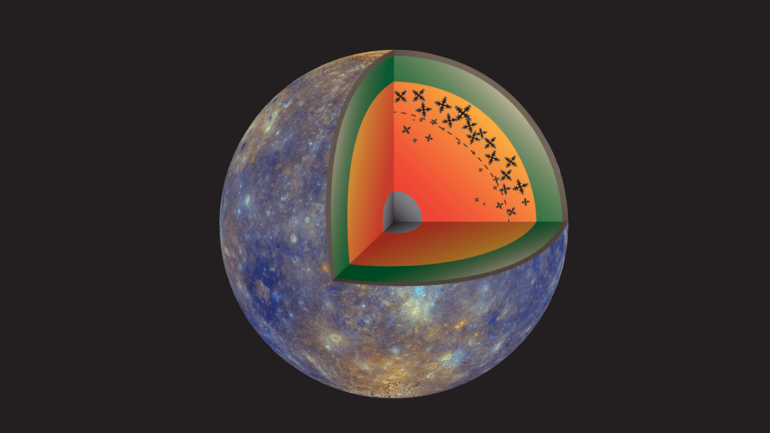Just as snow crystals form in the upper atmosphere, then fall to lower, warmer elevations and melt, scientists believe a phenomenon called iron snow happens in the molten iron cores of some planetary bodies. Cooling near the core-mantle boundary creates crystals of iron, which melt as they fall deeper into the hot core. This movement may create magnetic fields in some smaller bodies like Mercury and Jupiter’s moon Ganymede, but its dynamics are not well known.
In a first-of-its-kind experiment, Ludovic Huguet, and a research team, modeled iron snow in a lab using water ice and found distinct cycles of crystal formation and inactivity. Extrapolated to planetary bodies, the findings could mean planetary magnetic fields come and go periodically as their dynamos turn on and off.
The paper is published in the journal Geophysical Research Letters.
The researchers’ simple experimental setup involved a tank of water cooled from below, with a layer of salt water at the bottom to prevent ice crystal adhesion. As the lower layers of freshwater cooled, they produced ice crystals, which floated upward and melted once they reached warmer water. This created an overturning current that, along with latent heat created by crystal formation, eventually warmed lower layers of water and halted ice crystal formation. When the water cooled sufficiently again, the process started over.
The researchers found that these “bursts” of crystal formation repeated about every 1,400 seconds in their experiments. This rate was controlled by heat diffusion in the cooling layer, with some variability likely because of the heterogeneity of crystal nucleation.
Their model indicated that planetary bodies with molten iron cores may go through similar bursts of iron snow formation that create internal fluid flows in the molten iron, driving a periodic dynamo that generates a planetary magnetic field. Thus, magnetic fields may appear and disappear at semiregular intervals in these bodies.
Several questions about this process remain, the authors note, including what degree of supercooling is necessary for crystals to form, how iron snow particles move collectively, and how these movements affect large-scale flows within the core.
More information:
Ludovic Huguet et al, A Laboratory Model for Iron Snow in Planetary Cores, Geophysical Research Letters (2023). DOI: 10.1029/2023GL105697
This story is republished courtesy of Eos, hosted by the American Geophysical Union. Read the original storyhere.
Citation:
Iron snow ebb and flow may cause magnetic fields to come and go (2024, January 3)



